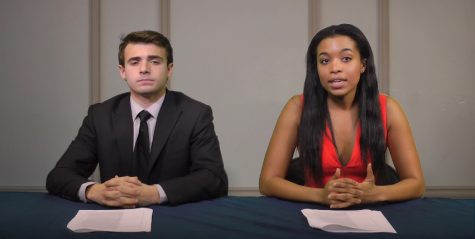In a tight dorm-room-sized space carpeted in red with one lime-green wall and a purple loveseat, UPTV is making big plans for the future of Pitt student media.
UPTV merged with “Pitt Tonight” and Pitt in Hollywood to relaunch the once popular station for the first time in seven years. UPTV, which debuted with a full lineup of shows Jan. 30, will become an all-encompassing media network. Although UPTV broadcasts to the dorms via Channel 68, students can also watch programs on Facebook and YouTube.
UPTV has sporadically posted content on its YouTube page — its last video before the relaunch was posted three months ago — but the station is now focusing primarily online, posting content almost daily.
The station released promos and first episodes of a few shows in preparation for the relaunch, and debuted to an audience of about 25,000 in the first day, according to video views.
Before the collaboration, “Pitt Tonight” was a late-night talk show and Pitt in Hollywood was a board of students who worked with outside organizations to connect media students and professionals.
“Our main goal is just to make all the media groups on campus more incorporated,” Lizzie Howard, a junior communication major, said. “We’d love to see [all the] media doing the same things, not working separately but together.”
Howard, who joined UPTV as a sophomore, now serves as the head of programming and manages multi-media content and promotional materials for UPTV.
Jesse Irwin, a senior film studies major and a well-known name amongst students for his role as “Pitt Tonight’s” host and creator, wants to ensure the work he’s done on campus continues to evolve after he graduates in the spring.
“Coming into this year, we kind of had the idea of taking this last year to merge … and make it something bigger,” he said.
He and Hayley Ulmer, a junior theater major and executive producer of “Pitt Tonight,” pitched the idea to combine the three separate organizations into one powerhouse last spring to UPTV President Mark Conner.
Before the merge, the station mostly focused on creating short, student-produced films. Pitt does not have a broadcast, print or visual journalism program, so media outlets on Pitt’s campus often serve as career training for aspiring students.
“I always felt like it was creating more of a divide amongst the kids who wanted to do visual media,” Irwin said.
However, he admitted that not all students in either media group were willing to merge under the umbrella of UPTV. Some students feared the new network would lack cohesion and creativity from the separate entities that were already established.
“We care enough about this to give up ‘Pitt Tonight’ as a student organization, give up Pitt in Hollywood as a student organization and sacrifice the mini communities we have in those organizations to create this umbrella organization,” Irwin said.
On the station’s newscast — the standard broadcast format Pitt has been missing — Zack Williams, a senior communication student, and Jade Nash, a first-year communication student, sit at a table covered in a simple blue tablecloth. On the first episode, they spoke to Andrew Zentgraf, vice president of Pitt College Republicans, who discussed his time at President Donald Trump’s inauguration.

Joining the newscast, the station is airing a sports show, “Roc Nation”; a superhero series, “ExtraExtraOrdinary”; “The End,” an anthology series about death; a sketch show called “Stop Trying to Make Sketch Happen” and a political news show, “The Bully PulPitt.”
“I think the one called ‘The End’ is the one that intrigues me the most,” Howard said. “[It’s] kind of set up as the same style as the ‘Twilight Zone,’ so every episode is kind of within its own universe, but they all deal with the transition between life and death.”
Run by Noah Livingston and Quinn Huang, each episode of “The End” is written and directed by different people spread out over the course of four episodes that are each less than 10 minutes long. Weeks of producing and editing take place before viewers see the final product — and that doesn’t include the four months of script writing that took place during the fall term.
Before the revival, UPTV was the brainchild of John Paul Horseman in 2002 and was originally referred to as a “creation station.”
“The idea behind UPTV originally was just really to provide a place — almost just like an equipment room — where you could take out a camera and just be yourself,” Irwin said. “The biggest thing, for me, is maintaining the integrity of what UPTV was originally founded to be, which was a center for creativity.”
Irwin and other media students, including the social media chair of Pitt in Hollywood, Luke Stambaugh, said before the merge, UPTV was only helpful to students who had some knowledge and competence in visual media.
“I think [UPTV] was like a platform for passion projects and like maybe one or two kids had those passion projects and a lot kids just wanted to hold a camera or learn how to write a script or learn how to hold a mic and so it was very centered on that,” Stambaugh, a junior computer science major, said.
Even though the merge is a pivotal step for Pitt’s media groups, Irwin said there is still much more that needs to be accomplished, including finding an advisor.
UPTV’s goal at the end of the semester is to have a system in place for all of the shows’ scheduling and programming. The network is made for students, by students, Irwin said.
“It’s a community of kids, and it’s always been a community — and that’s what’ll keep UPTV intact,” Irwin said.
Note: Jesse Irwin does multimedia work for The Pitt News, and The Pitt News is involved with two shows — the news and sportscasts — on the network.


